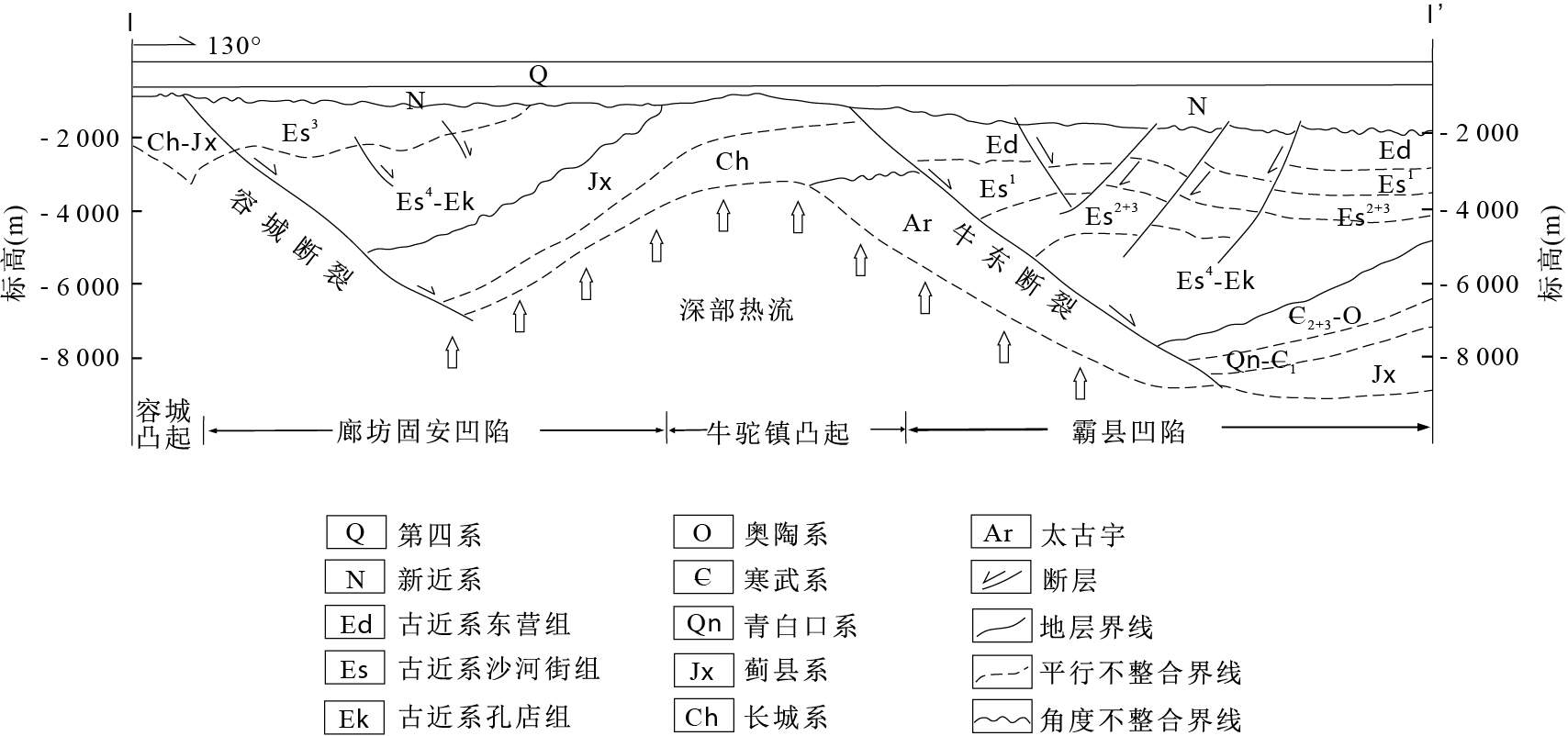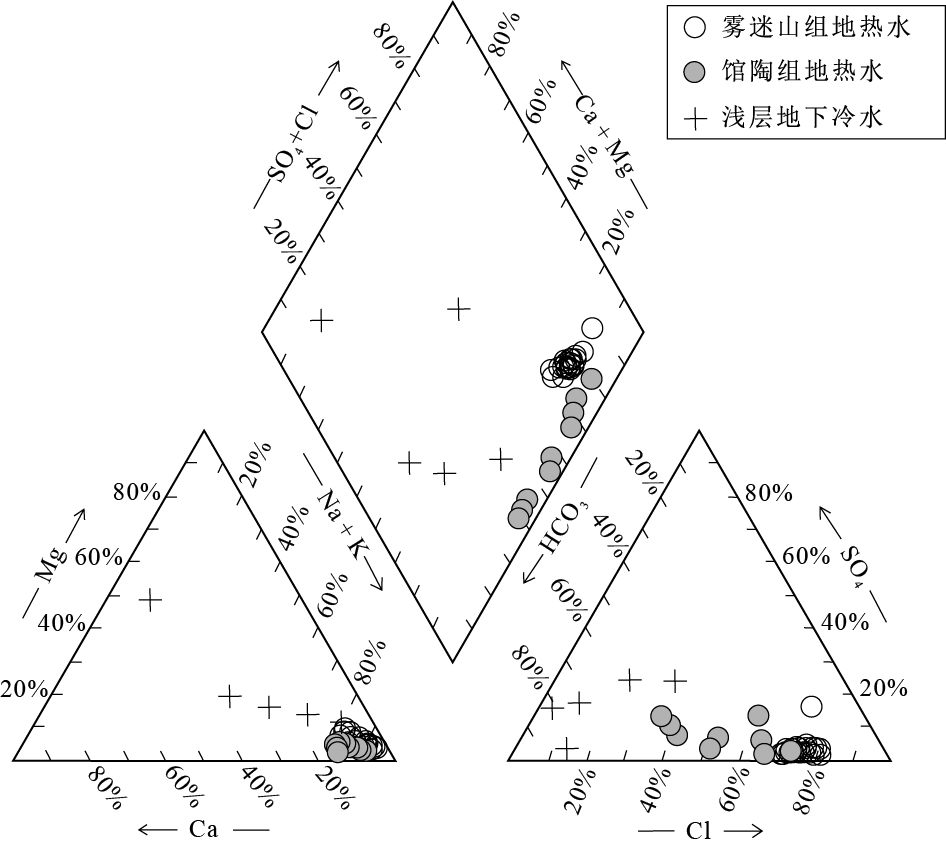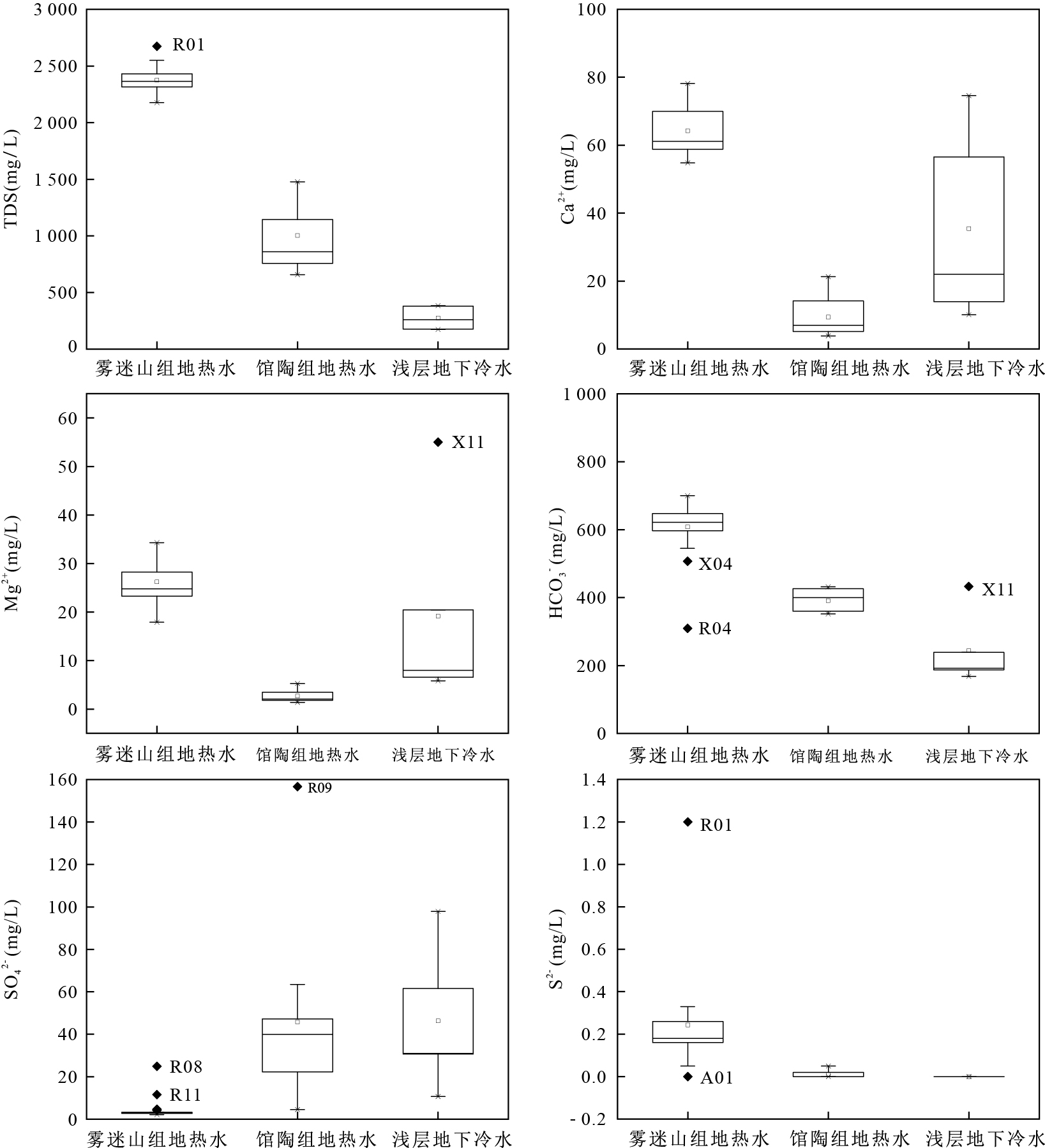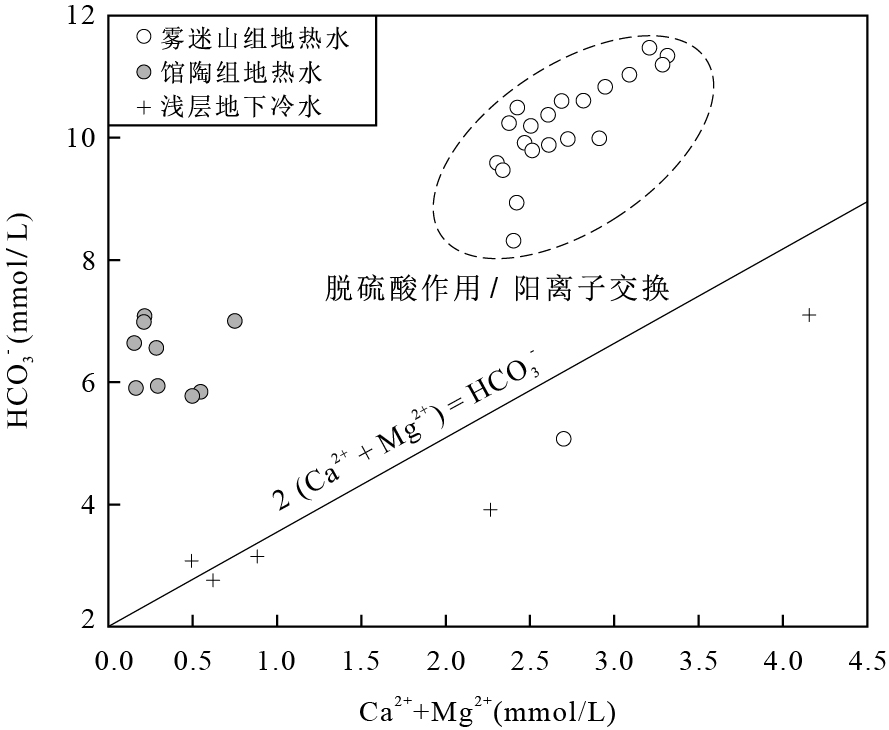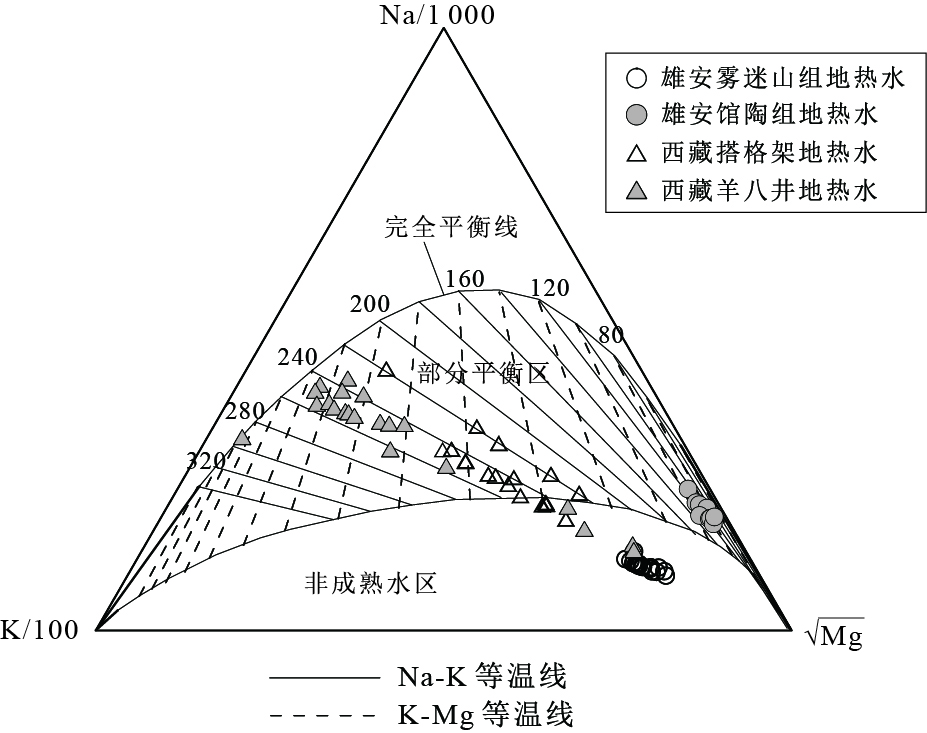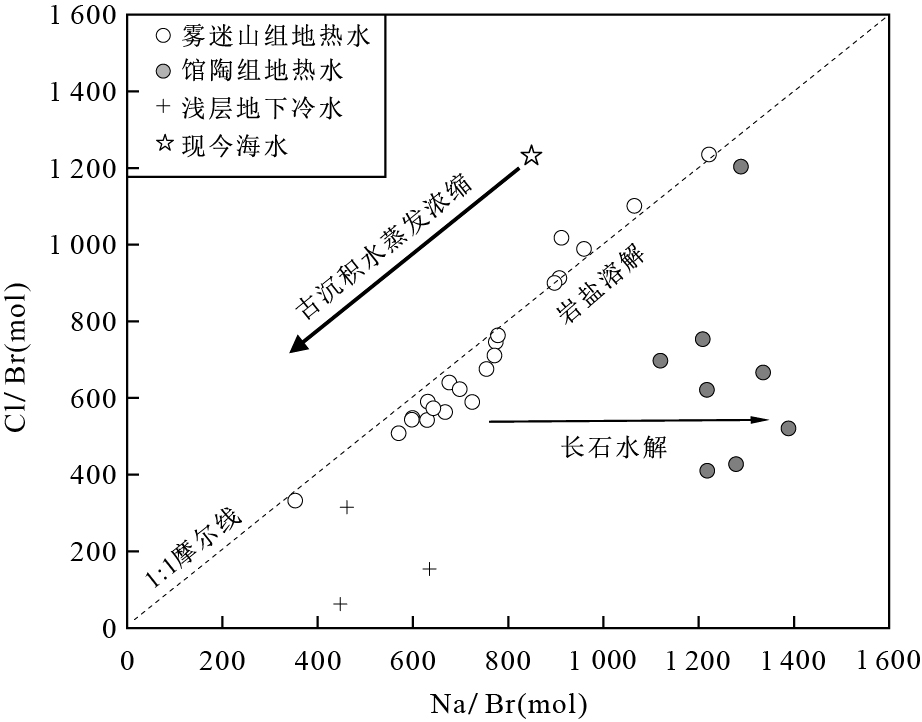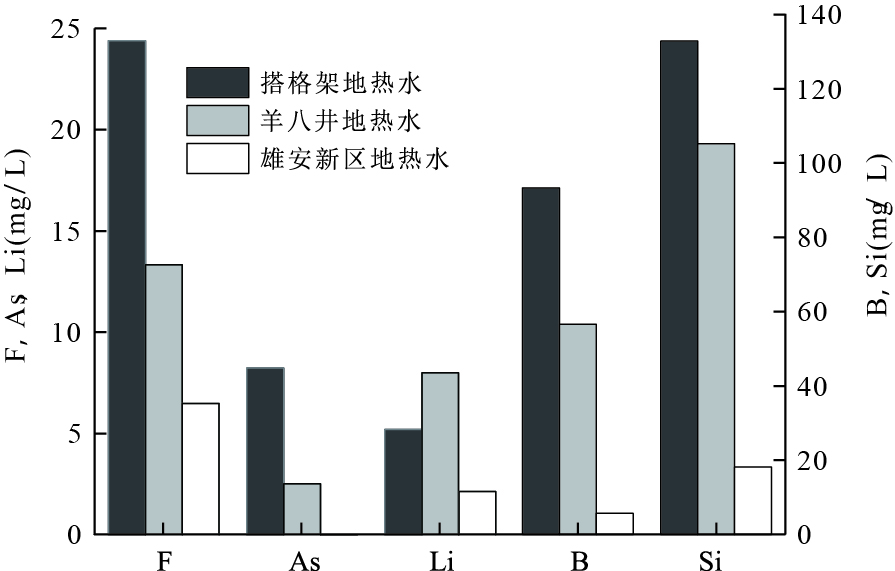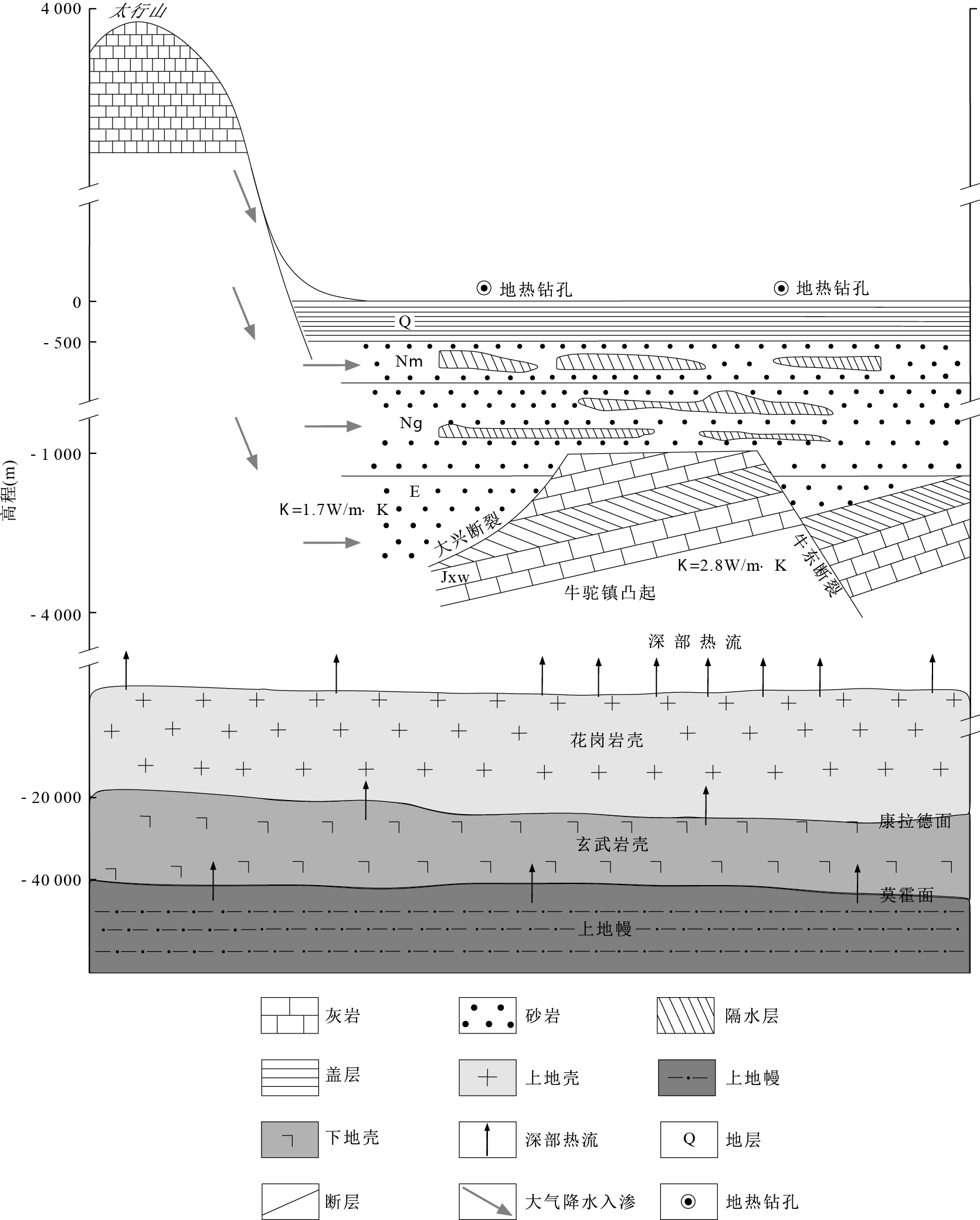Hydrogeochemistry of Geothermal Waters from Xiongan New Area and Its Indicating Significance
-
摘要: 地热流体水文地球化学研究是认识地热资源形成机制、赋存环境以及循环机理的有效手段.以我国华北平原典型的中低温地热系统——河北雄安新区为研究对象, 基于不同热储层和浅层地下冷水的水化学及同位素特征, 探讨地热流体中主要组分的地球化学起源, 评估深部地热流体的热储温度, 指示地热系统的深部热源及其成因机制.大气降水入渗、热储高温条件下的流体-岩石相互作用是雄安新区地热流体中主要组分的物质来源, 其中深层雾迷山组地热水中部分组分可能源于古沉积水蒸发浓缩过程中形成的蒸发岩盐的溶滤.雾迷山组地热水适宜利用Ca-Mg温标和石英温标计算其热储温度, 温度范围为76.4~90.6℃, 馆陶组地热水运用石英温标更为合理, 热储温度为66.2~71.3℃.雄安新区地热异常是深部放射性元素衰变热在特定的大地构造背景下聚集而形成.Abstract: Hydrogeochemical reaserch of geothermal fluids is an effective method to understand the formation mechanism, occurrence environment and circulation process of geothermal resources. Xiongan New Area, one of the typical low-temperature geothermal systems in the North China plain, is selected as the study area. In this study it is based on the analysis of water chemistry and isotopes, and aims: (1) to discuss the geochemical origin of main components in geothermal fluids, (2) to estimate the deep reservoir temperatures of geothermal waters, (3) to figure out the heat source beneath geothermal area and its genetic mechanism. The hydrochemical evidences imply that the main components in Xiongan geothermal waters are contributed by meteoric waters input and intense fluid-rock interactions at high reservoir temperatures, and several components of Wumishan Formation geothermal waters are from the dissolution of evaporation salt formed during the diagenetic process. The Ca-Mg and quartz geothermometer are suitable for estimating the reservoir temperature of Wumishan Formation geothermal waters, while that for Guantao Formation geothermal waters, the quartz geothermometer is much more appropriate. The calculated temperatures range from 76.4 to 90.6 ℃ and 66.2 to 71.3 ℃, respectively. The geothermal anomaly beneath Xiongan is likely to result from decay of radioactive elements in a specific tectonic setting.
-
Key words:
- hydrogeochemistry /
- geochemical origin /
- geothermometer /
- geothermal anomaly /
- Xiongan New Area
-
图 1 雄安地热区构造位置简图(改自Wang et al., 2013)
Fig. 1. Simplified structural map of the Xiongan geothermal area (after Wang et al., 2013)
图 2 雄安地热区前新生代地质简图及采样位置
Fig. 2. Pre-Cenozoic geological map of the Xiongan geothermal area and sampling locations
图 7 雄安和西藏地热水Na-K-Mg三角图
羊八井和搭格架数据分别来源于Yuan et al.(2014)和Liu et al.(2019)
Fig. 7. Na-K-Mg triangular diagram for Xiongan and Tibetan geothermal water samples
图 10 雄安新区、西藏羊八井和搭格架地热水化学组分柱状图
羊八井和搭格架数据分别来源于Yuan et al.(2014)和Liu et al.(2019)
Fig. 10. Histograms of the average concentrations of major constituents in Xiongan, Yangbajain and Daggyai geothermal waters
-
Ármannsson, H.2016.The Fluid Geochemistry of Icelandic High Temperature Geothermal Areas.Applied Geochemistry, 66:14-64. https://doi.org/10.1016/j.apgeochem.2015.10.008 Birkle, P, Marín, E.P, Pinti, D.L, et al.2016.Origin and Evolution of Geothermal Fluids from Las Tres Vírgenes and Cerro Prieto Fields, Mexico-Co-Genetic Volcanic Activity and Paleoclimatic Constraints.Applied Geochemistry, 65:36-53. https://doi.org/10.1016/j.apgeochem.2015.10.009 Blasco, M, Auqué, L.F, Gimeno, M.J, et al.2017.Geochemistry, Geothermometry and Influence of the Concentration of Mobile Elements in the Chemical Characteristics of Carbonate-Evaporitic Thermal Systems, the Case of the Tiermas Geothermal System (Spain).Chemical Geology, 466:696-709. https://doi.org/10.1016/j.chemgeo.2017.07.013 Brown, L.D, Zhao, W, Nelson, K.D, et al.1996.Bright Spots, Structure, and Magmatism in Southern Tibet from INDEPTH Seismic Reflection Profiling.Science, 274(5293):1688-1690. https://doi.org/10.1126/science.274.5293.1688 Cartwright, I, Weaver, T.R, Fifield, L.K.2006.Cl/Br Ratios and Environmental Isotopes as Indicators of Recharge Variability and Groundwater Flow:An Example from the Southeast Murray Basin, Australia.Chemical Geology, 231(1-2):38-56. https://doi.org/10.1016/j.chemgeo.2005.12.009 Chen, L, Booker, J.R, Jones, A.G, et al.1996.Electrically Conductive Crust in Southern Tibet from INDEPTH Magnetotelluric Surveying.Science, 274(5293):1694-1696. https://doi.org/10.1126/science.274.5293.1694 Cheng, M.X.1988.Geothermics in North China.Science Press, Beijing(in Chinese). Cheng, M.X, Wang, J.Y, Deng, X.1996.The Map of Geothermal System Types in China and Its Brief explaination.Scientia Geologica Sinica, 31(2):114-121 (in Chinese with English abstract). http://en.cnki.com.cn/Article_en/CJFDTotal-DZKX602.001.htm Cheng, M.X, Wang, J.Y, Wang, J.A, et al.1990.The Characteristics of the Geothermal Field and Its Formation Mechanism in the North China Down-Faulted Basin.Acta Geologica Sinica, 64(1):80-91 (in Chinese with English abstract). http://en.cnki.com.cn/Article_en/CJFDTotal-DZXE199001007.htm Chiodini, G, Frondini, F, Marini, L.1995.Theoretical Geothermometers and pCO2 Indicators for Aqueous Solutions Coming from Hydrothermal Systems of Medium-Low Temperature Hosted in Carbonate-Evaporite Rocks.Application to the Thermal Springs of the Etruscan Swell, Italy.Applied Geochemistry, 10(3):337-346.https://doi.org/10.1016/0883-2927(95)00006-6 Guo, Q.H.2012.Hydrogeochemistry of High-Temperature Geothermal Systems in China:A Review.Applied Geochemistry, 27(10):1887-1898. https://doi.org/10.1016/j.apgeochem.2012.07.006 Guo, S.Y, Li, X.J.2013.Reservoir Stratum Characterstics and Geothermal Resources Potential of Rongcheng Uplift Geothermal Field in Baoding, Hebei.Chinese Journal of Geology, 48(3):922-9321 (in Chinese with English abstract). http://www.wanfangdata.com.cn/details/detail.do?_type=perio&id=dzkx201303026 Hoke, L, Lamb, S, Hilton, D.R, et al.2000.Southern Limit of Mantle-Derived Geothermal Helium Emissions in Tibet:Implications for Lithospheric Structure.Earth and Planetary Science Letters, 180(3-4):297-308.https://doi.org/10.1016/s0012-821x(00)00174-6 doi: 10.1016/S0012-821X(00)00174-6 Kaygusuz, K, Kaygusuz, A.2004.Geothermal Energy in Turkey:The Sustainable Future.Renewable and Sustainable Energy Reviews, 8(6):545-563. https://doi.org/10.1016/j.rser.2004.01.001 Kind, R, Ni, J, Zhao, W, et al.1996.Evidence from Earthquake Data for a Partially Molten Crustal Layer in Southern Tibet.Science, 274(5293):1692-1694. https://doi.org/10.1126/science.274.5293.1692 Li, C.S, Wu, X.C, Sun, B, et al.2018.Hydrochemical Characteristics and Formation Mechanism of Geothermal Water in Northern Ji'nan.Earth Science, 43(Suppl.1):313-325(in Chinese with English abstract). http://d.old.wanfangdata.com.cn/Periodical/dqkx2018z1027 Li, J.X, Guo, Q.H, Yu, Z.Y.2017.Impact of Clay Mineral Formation in High-Temperature Geothermal System on Accuracy of Na-K and K-Mg Geothermometers.Earth Science, 42(1):142-154(in Chinese with English abstract). http://www.wanfangdata.com.cn/details/detail.do?_type=perio&id=dqkx201701011 Li, W.W, Rao, S, Tang, X.Y, et al.2014.The Drilling Temperature Measurement and Geothermal Field Characteristics of Geothermal Field in Xiong County, Hebei Province.Chinese Journal of Geology, 49(3):850-863 (in Chinese). Lin, W.J, Liu, Z.M, Wang, W.L, et al.2013.The Assessment of Geothermal Resources Potential of China.Geology in China, 40(1):312-321 (in Chinese with English abstract). http://en.cnki.com.cn/Article_en/CJFDTotal-DIZI201301023.htm Liu, M.L, Guo, Q.H, Wu, G, et al.2019.Boron Geochemistry of the Geothermal Waters from Two Typical Hydrothermal Systems in Southern Tibet (China):Daggyai and Quzhuomu.Geothermics, 82:190-202. https://doi.org/10.1016/j.geothermics.2019.06.009 Makovsky, Y, Klemperer, S.L, Ratschbacher, L, et al.1996.INDEPTH Wide-Angle Reflection Observation of P-Wave-to-S-Wave Conversion from Crustal Bright Spots in Tibet.Science, 274(5293):1690-1691.https://doi.org/10.1126/science.274.5293.169 doi: 10.1126/science.274.5293.1690 Najafi, G, Ghobadian, B.2011.Geothermal Resources in Iran:The Sustainable Future.Renewable and Sustainable Energy Reviews, 15(8):3946-3951. https://doi.org/10.1016/j.rser.2011.07.032 Nelson, K.D, Zhao, W, Brown, L.D, et al.1996.Partially Molten Middle Crust beneath Southern Tibet:Synthesis of Project INDEPTH Results.Science, 274(5293):1684-1688. https://doi.org/10.1126/science.274.5293.1684 Pang, J.M, Pang, Z.H, Lü, M, et al.2018.Geochemical and Isotopic Characteristics of Fluids in the Niutuozhen Geothermal Field, North China.Environmental Earth Sciences, 77(1):12.https://doi.org/10.1007/s12665-017-7171-y doi: 10.1007/s12665-017-7171-y Pang, Z.H, Kong, Y.L, Pang, J.M, et al.2017.Geothermal Resources and Development in Xiongan New Area.Bulletin of the Chinese Academy of Science, 32(11):56-62 (in Chinese with English abstract). http://d.old.wanfangdata.com.cn/Periodical/zgdz-e202001015 Tang, Y.P, Wang, G.J, Tang, J.H, et al.2017.The Application of Soil Gas Method to Delineation of the Most Favorable Enrichment Area of the Sedimentary Basin Type Geothermal System.Geophysical and Geochemical Exploration, 41(1):22-28(in Chinese with English abstract). http://www.wanfangdata.com.cn/details/detail.do?_type=perio&id=wtyht201701004 Wang, G.L, Zhang, W, Lin, W.J, et al.2017.Research on Formation Mode and Development Potential of Geothermal Resources in Beijing-Tianjin-Hebei Region.Geology in China, 44(6):1074-1085 (in Chinese with English abstract). http://www.wanfangdata.com.cn/details/detail.do?_type=perio&id=zgdizhi201706004 Wang, S.F, Pang, Z.H, Liu, J.R, et al.2013.Origin and Evolution Characteristics of Geothermal Water in the Niutuozhen Geothermal Field, North China Plain.Journal of Earth Science, 24(6):891-902. https://doi.org/10.1007/s12583-013-0390-6 Wang, X.W, Wang, T.H, Zhang, X, et al.2019.Genetic Mechanism of Xiwenzhuang Geothermal Field in Taiyuan Basin.Earth Science, 44(3):1042-1056 (in Chinese with English abstract). http://d.old.wanfangdata.com.cn/Periodical/dqkx201903029 Wang, Y.B, Ding, W.P, Tian, Y, et al.2016.Genetic Analysis on High-Temperature Geothermal Water in Niutuo Geothermal Field, Heibei Province.Urban Geology, 11(3):59-64(in Chinese with English abstract). http://www.wanfangdata.com.cn/details/detail.do?_type=perio&id=csdz201603012 Wu, A.M, Ma, F, Wang, G.L, et al.2018.A Study of Deep-Seated Karst Geothermal Reservoir Exploration and Huge Capacity Geothermal Well Parameters in Xiongan New Area.Acta Geoscientica Sinica, 39(5):523-532(in Chinese with English abstract). http://d.old.wanfangdata.com.cn/Periodical/dqxb201805002 Yang, J.L, Liu, F.T, Jia, Z, et al.2018.The Hydrochemical and δ2H-δ18O Characteristics of Two Geothermal Fields in Niutuozhen of Hebei Province and Tianjin and Their Environmental Significance.Acta Geoscientica Sinica, 39(1):71-78(in Chinese with English abstract). http://www.wanfangdata.com.cn/details/detail.do?_type=perio&id=dqxb201801008 Yuan, J.F, Guo, Q.H, Wang, Y.X.2014.Geochemical Behaviors of Boron and Its Isotopes in Aqueous Environment of the Yangbajing and Yangyi Geothermal Fields, Tibet, China.Journal of Geochemical Exploration, 140:11-22. https://doi.org/10.1016/j.gexplo.2014.01.006 Zhang, D.Z, Liu, Z.G, Lu, H.L.2013.Geothermics in Hebei.Science Press, Beijing (in Chinese). Zhu, J.L, Hu, K.Y, Lu, X.L, et al.2015.A Review of Geothermal Energy Resources, Development, and Applications in China:Current Status and Prospects.Energy, 93:466-483. https://doi.org/10.1016/j.energy.2015.08.098 陈墨香.1988.华北地热.北京:科学出版社. 陈墨香, 汪集旸, 邓孝.1996.中国地热系统类型图及其简要说明.地质科学, 31(2):114-121. http://www.wanfangdata.com.cn/details/detail.do?_type=perio&id=QK199601035663 陈墨香, 汪集旸, 汪缉安, 等.1990.华北断陷盆地地热场特征及其形成机制.地质学报, 64(1):80-91. http://www.cqvip.com/Main/Detail.aspx?id=229735 郭世炎, 李小军.2013.河北保定容城凸起地热田储层属性与资源潜力.地质科学, 48(3):922-931. doi: 10.3969/j.issn.0563-5020.2013.03.026 李常锁, 武显仓, 孙斌, 等.2018.济南北部地热水水化学特征及其形成机理.地球科学, 43(增刊1):313-325. doi: 10.3799/dqkx.2018.206 李洁祥, 郭清海, 余正艳.2017.高温地热系统中粘土矿物形成对Na-K和K-Mg地球化学温标准确性的影响.地球科学, 42(1):142-154. doi: 10.3799/dqkx.2017.011 李卫卫, 饶松, 唐晓音, 等.2014.河北雄县地热田钻井地温测量及地温场特征.地质科学, 49(3):850-863. doi: 10.3969/j.issn.0563-5020.2014.03.012 蔺文静, 刘志明, 王婉丽, 等.2013.中国地热资源及其潜力评估.中国地质, 40(1):312-321. doi: 10.3969/j.issn.1000-3657.2013.01.021 庞忠和, 孔彦龙, 庞菊梅, 等.2017.雄安新区地热资源与开发利用研究.中国科学院院刊, 32(11):56-62. http://www.wanfangdata.com.cn/details/detail.do?_type=perio&id=674176908 汤玉平, 王国建, 唐俊红, 等.2017.应用壤中气方法圈定沉积盆地型地热田的地热最有利富集区.物探与化探, 41(1):22-28. http://d.old.wanfangdata.com.cn/Periodical/wtyht201701004 王贵玲, 张薇, 蔺文静, 等.2017.京津冀地区地热资源成藏模式与潜力研究.中国地质, 44(6):1074-1085. http://d.old.wanfangdata.com.cn/Periodical/zgdizhi201706004 汪新伟, 王婷灏, 张瑄, 等.2019.太原盆地西温庄地热田的成因机制.地球科学, 44(3):1042-1056. doi: 10.3799/dqkx.2018.387 王永波, 丁文萍, 田月, 等.2016.河北牛驼镇地热田高温地热水成因分析.城市地质, 11(3):59-64. doi: 10.3969/j.issn.1007-1903.2016.03.011 吴爱民, 马峰, 王贵玲, 等.2018.雄安新区深部岩溶热储探测与高产能地热井参数研究.地球学报, 39(5):523-532. http://d.old.wanfangdata.com.cn/Periodical/dqxb201805002 杨吉龙, 柳富田, 贾志, 等.2018.河北牛驼镇与天津地热田水化学和氢氧同位素特征及其环境指示意义.地球学报, 39(1):71-78. http://d.old.wanfangdata.com.cn/Periodical/dqxb201801008 张德忠, 刘志刚, 卢红柳.2013.河北地热.北京:地质出版社. -
 dqkx-45-6-2221-Table1-4.pdf
dqkx-45-6-2221-Table1-4.pdf

-










 下载:
下载:

